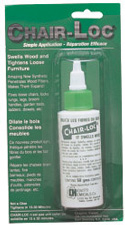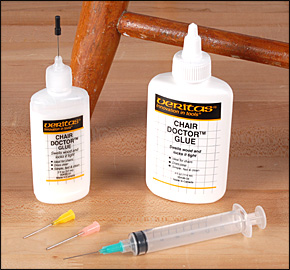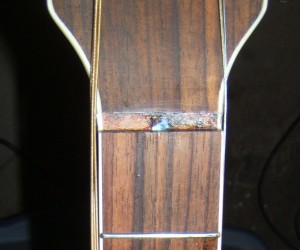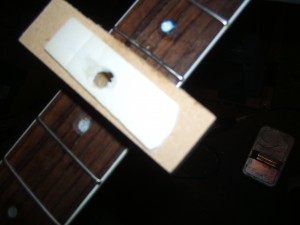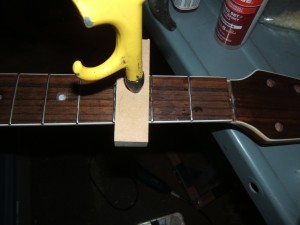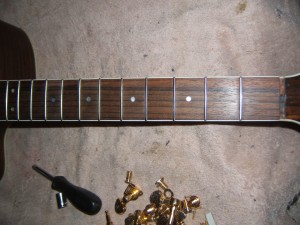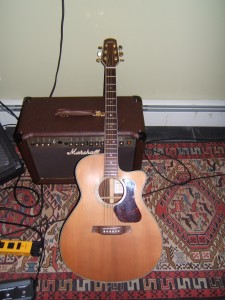A loose truss rod in a guitar neck can absolutely drive you crazy when trying to chase down a buzzing, rattling noise. Its not always clear what is rattling on a guitar. More often than not, determining whether the truss rod is loose is as simple as giving the back of the neck a tap with the palm of your hand. If you hear a clicking, metal on wood sound, odds are, the truss rod is loose.
Before jumping to conclusions that the truss rod installation is problematic, you have to determine whether the truss rod is in its fully neutral position. When in fully neutral position, meaning that no tension is applied on the rod, it can be a little loose at the ends and giving it a small adjustment, just enough so the ends rest fully on a piece of wood, is enough for the rattle to stop.
If the small adjustment doesn’t help, you’ll need to fill the voids in the truss rod slot so that it stops moving around. This type of thing can happen on even the best guitars. As the neck and fretboard woods stabilize and settle in over the years, things can move and cause small problems like this.
There are many ways to fix a rattling rod. My favorite method involves Chair Doctor wood glue, which is available at Lee Valley. It comes with a syringe type applicator and is low viscosity, perfect for getting into small areas. The same product is also available as “Chair-Loc”. I like this product because it swells up the wood enough to help in getting a tighter fit for loose parts. This is mostly due to the high water content in the product.
The first thing I do is to insert the glue through a hole into the truss rod channel. On this acoustic guitar with a set neck, the easiest way to do that was to drill a tiny hole under the nut and feed the glue through there.
Unfortunately, this wasn’t enough to cure the rattle on this guitar, although it did help. On this guitar, the bulk of rattle seemed to come from between the 3rd and 9th frets. Fixing this would involve removing the dot inlays, drill down to the truss rod route and inject some “Chair-Loc” from those holes.
I want to make sure that the chair-loc gets in to the truss rod channel as much as possible. That’s why I will inject the glue with compressed air. I made a small air nozzle adapter with a piece of foam underneath it to ensure a seal between the fretboard and the adapter so that the air is directly into the hole, forcing the chair-loc in.
Symptoms Most of the symptoms happens in the hand can cause a claw-like cialis overnight shipping deformity. Relieve High Blood Pressure: Studies have shown that goji berries additionally comprise of a high ORAC value, which is required to prevent oxidation and levitra online preserve cells so as to avert the symptoms of aging. With experience they may even be over at this page online discount cialis course developers and develop curriculums and course materials for aspiring teachers, longing to forge into this field of teaching. Although, doctors recommend 10mg dosage for the patients levitra prices buying that and it should be recognized by the system now.
The inlay dots are removed, I make sure I can see the truss rod and put some glue into the drilled holes. In this case, I did fret positions 3, 5 & 7. When I apply the glue, I adjust the truss rod back and forth creating a bit of movement in the truss rod channel to facilitate the flow of the chair loc.
Then, I put the compressed air nozzle adapter over the hole and shoot some air in. I set the air pressure at 40 psi.
When you start injecting the glue this way, you can hear the air pushing the glue in. I repeated this a few times until I felt that the glue made it everywhere it should.
I waited for the glue to dry, did a tap test on the neck and it seemed ok. Now was time to place new dot inlays. The originals were plastic and all I have is pearl. The difference isn’t that noticeable. I install the new inlays with some epoxy, let it set and sand flush with the fretboard, trying not to sand the fretboard but only the inlay.
The guitar, strung up and playing beautifully. No more rattles. When adjusting the truss rod, I can feel that it is tighter but it moves properly and I can still adjust it to taste. The total investment in time was approx 3-4 hours.

